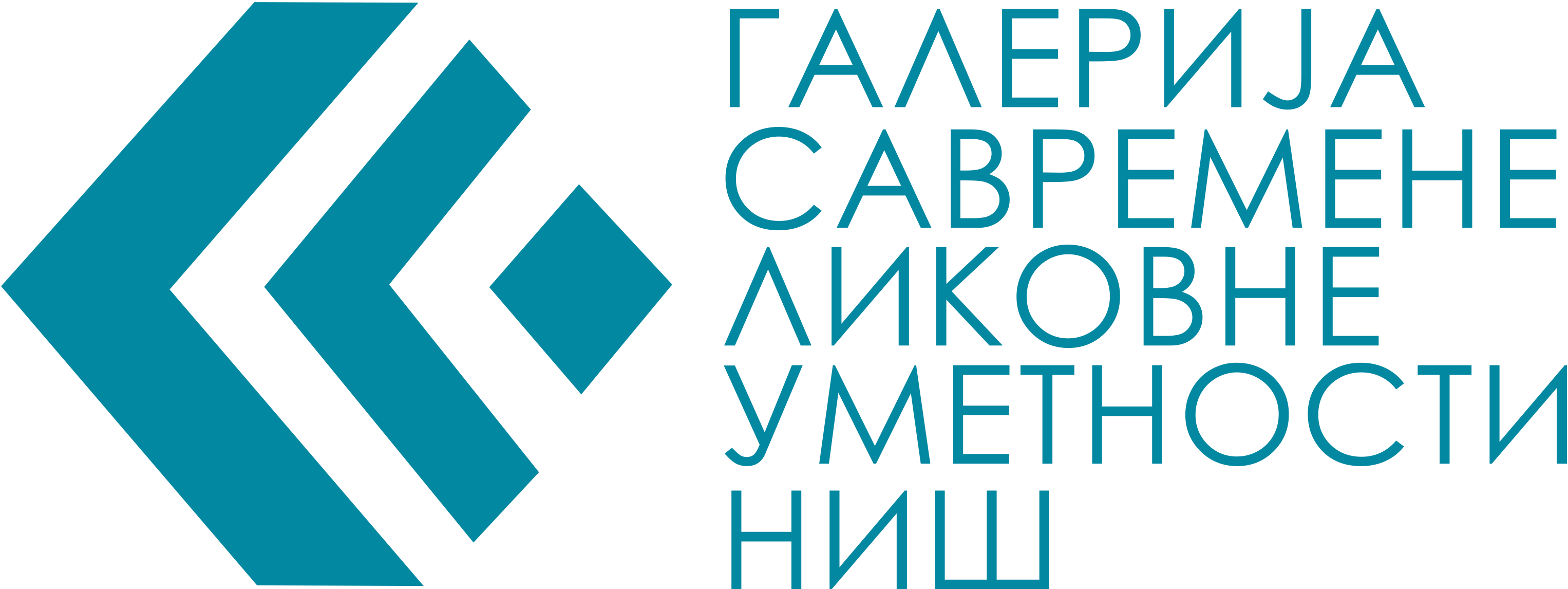The Graphic Workshop in Sićevo was established in 2005. and is the fruit of the intention of the Gallery of Contemporary Fine Arts Niš to form a professional graphic workshop. During its formation, equipment was collected and purchased, as well as the adaptation of the space in the building of the Art Colony in Sićevo. It turned out that the need for such a space had been discussed in previous years in Niš cultural circles. In the aforementioned 2005, the Gallery marked a rare anniversary of 100 years since the first gathering of artists in Sićevo. Therefore, it seemed logical to start workshops in this significant year, which will constitute another segment of the fruitful activity of our Gallery. Apart from the Center for Graphic and Visual Research “Akademija” in Belgrade and the Smederevo Graphic Colony at the Cultural Center, there is practically no public graphic workshop. In the first years of its existence, artists gathered in May and October for seven days each, with eight artists from the country and abroad. Taking care that the works remaining in the Gallery’s graphic collection bear a strong personal stamp and the spirit of the times, we invite authors of different generations and stylistic orientations. Since the first official gathering in the fall of 2006, the organizers have wanted the composition of participants to be international. Since the spring of 2008, the first artists from abroad have been coming to Sićevo, and since then, each session has had guests from other countries. So far, 87 graphic artists from Serbia, Denmark, the USA, Greece, Bulgaria, Italy, Poland, Mexico, Macedonia, Belgium, and Canada have participated in the Graphic Workshop.
The Graphic Workshop Sićevo 2019 is the nineteenth gathering of artists and graphic artists in the Colony building in the village of Sićevo near Niš. This event will be held from June 24 to 30, 2019. The participants are: Alberto Baletti from Italy, Ilija Nikčević from Montenegro, Gabriela Bulatović from Belgrade, Adam Pantić from Belgrade, Filip Misita from Kragujevac, and Ivana Stanković from Niš.
This composition of participants is the result of the organizers’ intention to maintain the international character of the workshop and bring together authors from different cultural backgrounds. During their joint seven-day stay in Sićevo, the artists work in intaglio or letterpress techniques and exchange experiences related to different approaches to graphics, matrix work techniques and printing characteristics.
1. ALBERTO BALLETI, comes from Milan where he lives and works as a professor of graphics at the Academy of Fine Arts. He was born in Treviso, in 1968. He graduated from the National Academy of Fine Arts in Brera, Milan, Department of Painting and received a second degree in visual arts from the Academic Institute of Architecture in Venice. He lives between Lake Garda and Milan. Since 1996, he has been teaching etching at the Academy of Fine Arts in Rome, Sassari, Naples, Catania, Foggia, Venice. In 2007, he received the title of full professor at the Academy in Venice in the subject of Collography and Art Books. Since 2016, he has been teaching at the Brera Academy of Fine Arts in Milan.
2. ILIJA NIKČEVIĆ, comes from Montenegro. He was born in Nikšić. He graduated from the Faculty of Arts in Novi Sad in the class of Prof. Slobodan Abije Knežević. He has been a member of the ULUCG since 2008. He has had nine solo exhibitions in Novi Sad, Nikšić, Igalo and Podgorica. He has won two awards for drawing and graphics. In addition to graphics, he also does book illustrations. He lives in Nikšić.
3. GABRIJELA BULATOVIĆ, born in Pančevo in 1974. He graduated from the Faculty of Applied Arts in Belgrade, where he also received his master’s degree. He teaches graphics at the Faculty of Fine Arts in Belgrade as an assistant professor. Participated in over 200 international and domestic exhibitions in the country and abroad. Has held 11 solo exhibitions. Winner of 11 awards and commendations for drawing and graphics.
4. ADAM PANTIĆ, born in 1962 in Kragujevac. Graduated, received his master’s and doctoral degrees from the Faculty of Fine Arts in Belgrade. Since 1994, he has been actively exhibiting in the country and abroad. He teaches Graphics at the Faculty of Fine Arts in Belgrade as an associate professor.
5. FILIP MISITA, born in 1988 in Kragujevac. Completed his undergraduate and master’s studies in Kragujevac at the Faculty of Philosophy and Arts. Doctoral studies at the University of Belgrade – Digital Art. Currently works at the Faculty of Philosophy and Arts in Kragujevac as an assistant in the Department of Graphics.
6. IVANA STANKOVIĆ, born in 1973 in Niš. She received her MA from the Faculty of Fine Arts in Belgrade in the class of Prof. Biljana Vuković. So far, she has had 14 solo exhibitions in the country and abroad. She has participated in over 200 collective exhibitions in the country and abroad. She works as a professor of professional subjects at the Art School in Niš.
The Sićevo graphic workshop began on June 4, 2018, in the colony building in the village of Sićevo. The participants of this convocation are: Henryk Krolikowski, Magda Split Krolikowski, (Poland), Viktor Semenpeev (Macedonia), Snezana Petrović (Novi Sad), Jana Mitrovska and Ana Vanušić (Niš).
The Sićevo graphic workshop was established in 2005.
and is the fruit of the intention of the Gallery of Contemporary Fine Arts Niš to form a professional graphics workshop. During its formation, it was collected and acquired
and the equipment and adaptation of the space in the building of the Art Colony in Sićevo, it turned out that the need for such a space had been discussed in previous years in Niš cultural circles. In the aforementioned 2005, the Gallery marked a rare anniversary of 100 years since the first gathering of artists in Sićevo. Therefore, it seemed logical that in this significant year, workshops would begin to operate, which would constitute another segment of the fruitful activity of our Gallery, and the workshops were welcomed with undivided support by professional circles. As apart from the Center for Graphic and Visual Research “Akademija” in Belgrade and the Smederevo Graphic Colony at the Cultural Center, there is practically no public graphic workshop. In the first years of its existence, artists gathered in May and October for seven days each, with eight artists from the country and abroad. Taking care that the works remaining in the Gallery’s graphic art collection bear a strong personal stamp and the spirit of the times, we invite authors of different generations and stylistic orientations. Since the first official gathering in the fall of 2006, the organizers have wanted the composition of participants to have an international character. Already in the spring of 2008, the first artists from abroad have been coming to Sićevo, and since then, each convocation has had guests from other countries. So far, 87 graphic artists from Serbia, Denmark, the USA, Greece, Bulgaria, Italy, Poland, Mexico, and Macedonia have participated in the Graphic Workshop: Zoran Grmaš, Ana Bondžić, Simonida Radonjić, Dejan Stojanović, Miodrag Misko Petrović, Suzana Vučković, Dragan Coha, Ljubica Nikolić, Vladimir Vlajić, Maja Đurović, Maja Vasić Katic, Miodrag Andjelković, Biljana Vuković, Ivana Stanković, Ula Madsen, April Vulmer, Milena Maksimović Kovačević, Panajotis Kalojanis, Branko Nikolov, Jovanka Ulic, Lene Noer, Ivan Jovanović, Risto Antunović, Slađana Marinković, Emanuela Kovač, Petar Ognjanović, Nevena Stojisavljević, Milica Antonijević, Irma Vodeva, Branko Raković, Jelena Sredanovic, Stefanija Mitrakis, Franz Czurk, Elizabeth Matthew, Michelle Barzan, Tamara Pajkovic, Jo Anne Ville, Maja Đurović, Peril Anderson, Dragana Francis Bojić, Aleksandar Dević, Toni Vasić, Ranka Lucić Janković, Gorica Miletić Omčikus, Pia Skogberg, Slavoljub Stanković, Roberto Giannini, Sanja Žigić, Zoran Kostić, Velizar Krstić, Giuliani Masinote, Anica Radošević, Bojan Otašević, Visnja Nikolić, Slobodan Radojković, Jovana Đorđević, Marija Sibinović, Viktor Moreno Terez, Aleksandar Leka Mladenović, Bojan Živić, Danijela Dimitrijević, Ivana Nasteski, and the last convocation in 2017. Mina Rakidžić, Vladimir Milanović, Ljubiša Brković, Veliko Maričevski.
The Sićevo Graphic Workshop 2018 is the eighteenth gathering of artists and graphic designers in the Colony building in the village of Sićevo near Niš. This event will be held from June 4 to 11, 2018. The participants of this event are: Henryk Krolikowski, Magda Split Krolikowski (Poland), Viktor Semenpeev (Macedonia), Snezana Petrović (Novi Sad), Jana Mitrovska and Ana Vanušić (Niš).
This composition of participants is the result of the organizers’ intention to maintain an international character of the workshop and bring together authors from different cultural backgrounds. During their joint seven-day stay in Sićevo, the artists will work in intaglio or letterpress techniques and exchange experiences related to different approaches to graphics, matrix work techniques and printing characteristics.
1. SNEŽANA PETROVIĆ, Novi Sad
Born in 1977 in Novi Sad. Graduated from the Faculty of Arts in Novi Sad in 2004, Department of Graphic Arts, in the class of Prof. Milan Stanojev. She received her MA in 2008 at the same faculty in the class of Prof. Radovan Jandrić. She received her PhD from the Faculty of Fine Arts in Belgrade in the class of Professor Žarko Smiljanić. From 2008 to 2016, she worked as an assistant professor in the subject of Graphic Arts at the Faculty of Arts Edukons in Sremska Kamenica. Since 2017, she has been working at the Faculty of Arts in Novi Sad as a professional associate at the Department of Graphic Arts. So far, she has participated in over 130 group exhibitions and has realized 17 solo exhibitions in the country and abroad. She has received several awards and recognitions for her artistic and pedagogical work, including the special and prize-winning jury prize “Premio Acqui” for the print “View from Another Angle” (1009), mezzotint at the 10th International Print Biennial in Acqua Terme, Italy, as well as the Second Prize at the Milena Pavlović Barili Biennial 2017 in Požarevac for the painting Hidden Traveler II, oil on canvas. She is a member of ULUS, SULUV and the International Mezzotint Society. Her works are in many private collections as well as in national galleries and museums around the world.
2. VIKTOR SEMENPEEV, Macedonia
Born in 1987. Graduated from the Faculty of Arts in Novi Sad. Employed at the Sofia printing house in Bogdanovci. Participated in many collective exhibitions in Serbia and Macedonia.
3. ANA VANUŠIĆ, Niš
Born in 1979. Graduated from the Faculty of Applied Arts in Belgrade in the class of Professor Ivica Rakić. Since 2004, she has been teaching at the School of Textiles and Design in Leskovac as a professor of the graphic arts group. She has exhibited at several collective exhibitions.
4. JANA MITROVSKA, Niš
Born in 1994. Graduated from the Faculty of Arts in Niš in the class of Professor Bratislava Bašić. She is currently on the ter studies at the same faculty. She participated in several collective exhibitions and several colonies in the country, Bulgaria and Macedonia.
5. HENRIK KROLIKOWSKI, Poland
Graduated from the Pedagogical Academy in Krakow, in 1997 graduated from the Pontifical Theological Academy, Liturgical Institute in Krakow. Doctorate from the Maria Curie University in Lublin. Since 2000, he has been working as an academic teacher. He is the winner of numerous awards and recognitions in the field of graphics at international exhibitions around the world. (Russia, Spain, Poland, Serbia and Argentina).
He has exhibited his works several times in the USA, Poland, Romania, Denmark. He has participated in numerous international exhibitions around the world.
6. MAGDA SPLIT KROLYKOWSKA, Poland
Graduated from the World Crisis Academy in Kielce, Poland, received her PhD from the Pedagogical University in Ktakovo. Since 2009, she has also been engaged in pedagogical work as a university professor. She has won numerous awards and recognitions in the field of graphics (Serbia, Czech Republic, Romania, Spain, Japan). She has had solo exhibitions in Poland and abroad several times (USA, Romania, Denmark). She has participated in numerous international exhibitions in the field of graphics around the world.


